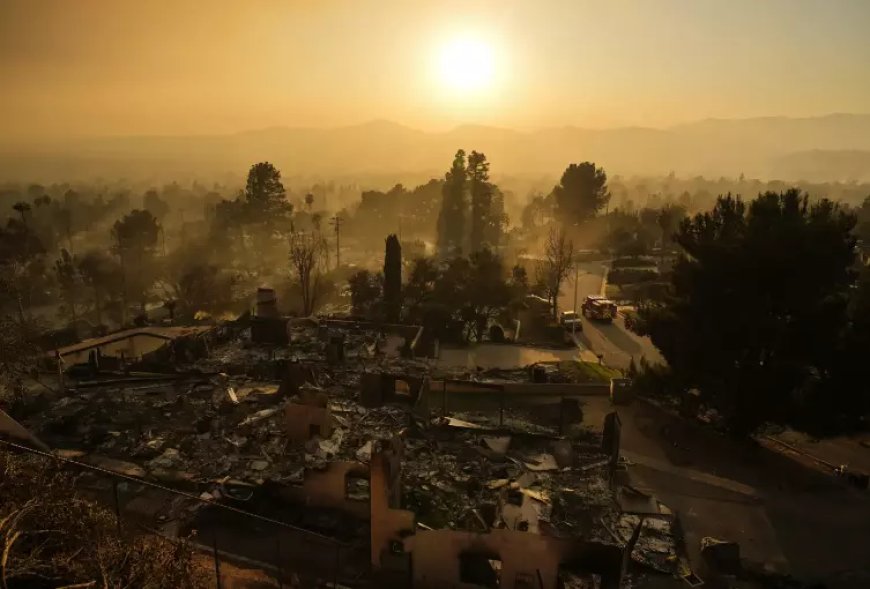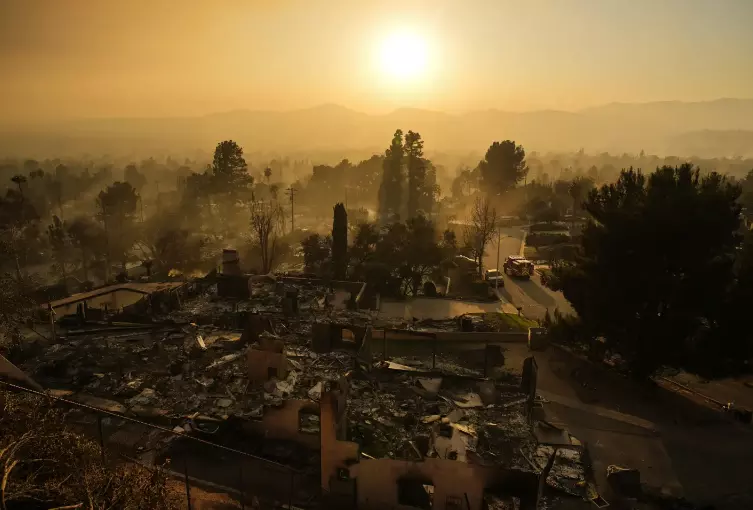Los Angeles Wildfires Kill 24, Displace Thousands, Destroy 12,000 Structures
Wildfires sweeping through the Los Angeles region have caused catastrophic destruction, claiming at least 24 lives, displacing thousands, and leveling over 12,000 structures. The fires, fueled by relentless Santa Ana winds, have scorched an area exceeding 62 square miles (160 square kilometers), larger than the city of San Francisco. Lives Lost and Missing Persons The Palisades Fire along the coastal areas has resulted in eight fatalities, while the more inland Eaton Fire has claimed 16 lives, according to the LA County medical examiner’s office. Additionally, at least 16 individuals remain missing, with authorities anticipating that the count may increase as search efforts continue. Economic and Infrastructure Damage Preliminary estimates by AccuWeather suggest these fires could rank as the most costly in U.S. history, with damages and economic losses projected between $135 billion and $150 billion. The fires have significantly damaged sewer, water, and power infrastructure across the region, complicating recovery efforts. Nearly 70,000 residents were without power as of Sunday, with over half of the outages reported in Los Angeles County, according to PowerOutage.us. Thousands remain evacuated, with around 150,000 under evacuation orders and more than 700 people seeking refuge in nine shelters. Officials warn that these evacuation orders are unlikely to be lifted before midweek, as the National Weather Service forecasts the return of strong Santa Ana winds through Wednesday evening. Fire Containment Efforts Cal Fire reports that containment progress varies across the fires. The Kenneth Fire near West Hills in the San Fernando Valley was fully contained as of Sunday morning, while the Hurst Fire was 89% contained. The Palisades Fire’s containment stood at 11%, and the Eaton Fire was 27% contained as of Sunday. Communities and Landmarks Ravaged The wildfires have torn through diverse neighborhoods, including Pacific Palisades, Altadena, and others. In Altadena, a historic haven for Black families escaping discriminatory housing practices was devastated. Entire neighborhoods known for their racial and economic diversity were reduced to ashes, with many homeowners losing their lifelong investments. The fires also destroyed multiple places of worship, including a mosque, a synagogue, a Catholic parish, and six Protestant churches. Beyond landmarks and celebrity homes—such as those of Billy Crystal, Mandy Moore, and Los Angeles Lakers head coach JJ Redick—the fires have upended lives across socioeconomic lines. Uncertain Cause of the Fires Investigators have yet to determine the cause of the wildfires. While lightning, the most common cause of U.S. fires, was ruled out due to the absence of thunderstorms, other possibilities remain under investigation. Authorities are focusing on intentional acts and utility line sparks as potential causes. Cultural and Community Impact The fires have also disrupted cultural events, with the Critics Choice Awards’ Sunday ceremonies in Santa Monica rescheduled for January 26. The wildfires have left many communities in mourning, grappling with the loss of both loved ones and irreplaceable landmarks. Looking Ahead As red flag warnings remain in effect, residents and officials brace for further challenges. The fierce Santa Ana winds, coupled with the region’s eight-month drought, are expected to intensify fire conditions. Recovery will be a long and arduous process for the thousands of residents displaced and the countless others impacted by this unprecedented disaster.


Wildfires sweeping through the Los Angeles region have caused catastrophic destruction, claiming at least 24 lives, displacing thousands, and leveling over 12,000 structures. The fires, fueled by relentless Santa Ana winds, have scorched an area exceeding 62 square miles (160 square kilometers), larger than the city of San Francisco.
Lives Lost and Missing Persons
The Palisades Fire along the coastal areas has resulted in eight fatalities, while the more inland Eaton Fire has claimed 16 lives, according to the LA County medical examiner’s office. Additionally, at least 16 individuals remain missing, with authorities anticipating that the count may increase as search efforts continue.
Economic and Infrastructure Damage
Preliminary estimates by AccuWeather suggest these fires could rank as the most costly in U.S. history, with damages and economic losses projected between $135 billion and $150 billion. The fires have significantly damaged sewer, water, and power infrastructure across the region, complicating recovery efforts.
Nearly 70,000 residents were without power as of Sunday, with over half of the outages reported in Los Angeles County, according to PowerOutage.us. Thousands remain evacuated, with around 150,000 under evacuation orders and more than 700 people seeking refuge in nine shelters. Officials warn that these evacuation orders are unlikely to be lifted before midweek, as the National Weather Service forecasts the return of strong Santa Ana winds through Wednesday evening.
Fire Containment Efforts
Cal Fire reports that containment progress varies across the fires. The Kenneth Fire near West Hills in the San Fernando Valley was fully contained as of Sunday morning, while the Hurst Fire was 89% contained. The Palisades Fire’s containment stood at 11%, and the Eaton Fire was 27% contained as of Sunday.
Communities and Landmarks Ravaged
The wildfires have torn through diverse neighborhoods, including Pacific Palisades, Altadena, and others. In Altadena, a historic haven for Black families escaping discriminatory housing practices was devastated. Entire neighborhoods known for their racial and economic diversity were reduced to ashes, with many homeowners losing their lifelong investments.
The fires also destroyed multiple places of worship, including a mosque, a synagogue, a Catholic parish, and six Protestant churches. Beyond landmarks and celebrity homes—such as those of Billy Crystal, Mandy Moore, and Los Angeles Lakers head coach JJ Redick—the fires have upended lives across socioeconomic lines.
Uncertain Cause of the Fires
Investigators have yet to determine the cause of the wildfires. While lightning, the most common cause of U.S. fires, was ruled out due to the absence of thunderstorms, other possibilities remain under investigation. Authorities are focusing on intentional acts and utility line sparks as potential causes.
Cultural and Community Impact
The fires have also disrupted cultural events, with the Critics Choice Awards’ Sunday ceremonies in Santa Monica rescheduled for January 26. The wildfires have left many communities in mourning, grappling with the loss of both loved ones and irreplaceable landmarks.
Looking Ahead
As red flag warnings remain in effect, residents and officials brace for further challenges. The fierce Santa Ana winds, coupled with the region’s eight-month drought, are expected to intensify fire conditions. Recovery will be a long and arduous process for the thousands of residents displaced and the countless others impacted by this unprecedented disaster.






































